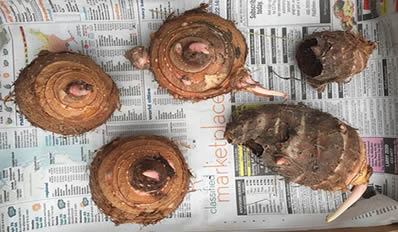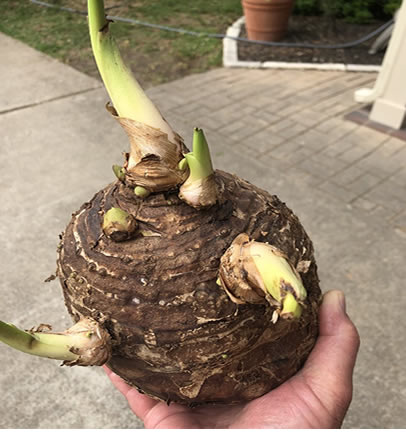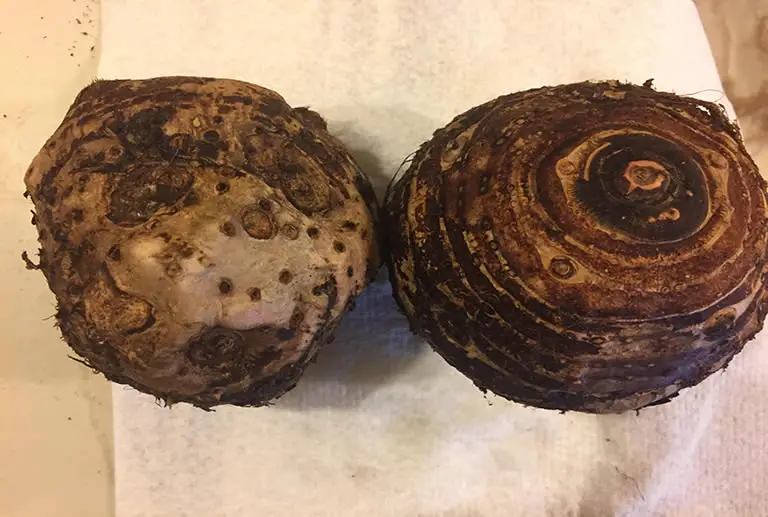Elephant ears are popular as both outdoor and indoor plants. But with no obvious way to tell which end of the bulb is which many newbie indoor and outdoor gardeners wonder which way you should plant an elephant ear bulb and if planting it upside down will result in growth problems.
Table of Contents
This is what happens when you plant a bulb upside down
So, what happens if you plant an elephant ear bulb upside down?
Planting an elephant ear bulb upside will not stop the plant from germinating.
It will merely slow down the process of the stem breaking through the soil by a few days or weeks.
Although it is advisable to plant bulbs right-side up, planting them upside down or even sideways will not stop the plant from growing.
Although planting a bulb upside will not cause restriction of germination, sprouting or growth, it will slow down the process somewhat in the beginning.
Let’s look at what exactly happens to a bulb when it is planting upside down.
When you plant a bulb upside germination still happens.
When the bulb starts to sprout the stem will naturally orientate itself towards the sun.
However, in order to break through the soil surface the stem will have to navigate extra space as it initially sprouts downwards and must reorient itself towards the surface.
This slows down initial growth but once the shoot has broken the surface the plant will grow at a normal rate.
It is completely natural for a bulb to grow if it is planted upside down (or even sideways for the matter).
Why?
Because if planting a bulb upside down stopped plant growth then many plant species may well have died out long ago before mankind ever began plant cultivation.
In nature seeds and bulbs fall onto the ground in all different kinds of positions. So it is necessary that they are able to germinate and sprout regardless of the position the bulb finds itself in when it falls in the soil.
Once the bulb sprouts, the stem must be able to break through the soil surface in order for the plant to survive.
It therefore must be able to do this regardless of the position of the bulb is in, in the soil.
It is a inbuilt mechanism within all plants to seek out light and so, as a bulb sprouts and a stem begins to grow, it will naturally seek sunlight and thus orientate itself to the sun.
Obviously if the bulb is planted upside down the initial sprouting will occur in the wrong direction.
As the stem grows there is therefore additional space, filled with soil, that the stem must navigate before it can reorient itself upwards and eventually break through the soil surface.
Therefore, it can take a little longer, from a few days to a few weeks, for a bulb planted upside down to produce its first above ground stem.
Once the plant has started growing above ground its growth rate will be the same as it would be if the bulb had been planted right-side up as long. As long as you water and feed the plant correctly of course.
How to properly plant elephant ear bulbs
There are several different plant species that qualify as elephant ear plants.
All of these bulbs look similar and the orientation for planting can be confusing for people when it comes time to plant them.
When it comes time to plant your specific elephant ear plant it can feel like a puzzle determining which end of the bulb is which, and thus difficult to know which way to plant it.

Above you can see an image of different types elephant ear bulbs and tubers.
If you are planting a tuber then the pointed end should go in head first and the flatter end should be facing the surface.
A typical elephant ear bulb, and most likely the one you will be planting, is round with no discernible points indicating which end is which.
Luckily though, in most cases the bulb will have a smooth side and a bumpy side – as you can clearly see in the featured image on this page.
It is from the smooth end of the elephant ear bulb that the plant stem sprouts and it is the bumpy end where most of the roots form.
So you should plant an elephant ear bulb smooth side up, bumpy side down.
The depth of planting should be about 4 inches. If planting in pots the ideal width of pot will differ between species.
How deep to plant elephant ear bulbs
Elephant ear plants are popular both as an outdoor garden plant, that is cultivated and grown directly in the yard, and also as an outdoor and indoor potted plant.
Elephant ear bulbs planted outdoors should be planted at least 2 – 4 feet apart.
Plant them about 4 inches deep i.e., the top of the bulb should be about 4 inches below the soil surface when covered.
Indoor potted elephant ear bulbs should be planted in containers made from non porous materials. Glazed clay, ceramic and plastic work well as they help retain moisture in the soil better than the more common and more popular terracotta pots.
I personally try to avoid using plastic for plants that will stay in the pot long-term though.
Although I frequently use plastic pots for plant propagation I avoid using them as permanent containers. Plastic, being a byproduct of oil, tends to break down over time and release harmful chemicals into the soil.
Width of pots should differ between elephant ear plant species.
For Colocasia varieties of elephant ears a container or pot that is at least 18 inches wide is recommended while for the much larger Alocasia varieties a 36 inches wide container is best.
By using a large pot or container you will allow the plant to grow to its full potential and also mitigate the need for repotting as the elephant ear plant continues to grow.
Another pro of using a large pot is water retention.
Bigger pots will dry-out much more slowly than smaller ones and are thus protecting your water-thirsty elephant ear plant from drought.
When potting be sure to plant the elephant ear bulb about 4 inches below the soil surface in the same way you would plant it outdoors i.e. ensuring that at least 4 inches of soil lay above the top of the bulb.
The pot should have sufficient depth to encourage growth.
Most pots at the width specifications given above will be sufficiently deep for an elephant ear plant to grow healthily but make sure any container you are using is at least 16 inches deep.
An elephant ear plant will grow in most nutrient-rich soils however adding a good potting compost, especially to indoor potted plants, will greatly help the soil retain its moisture.
Caring for an elephant ear plant before, during and after bulb germination
Caring for an elephant ear plant is fairly easy.
Elephant ears require a lot of water so be sure that you understand how much you need to give your plant to maintain healthy growth and a healthy plant.
No matter what you read online, never feed your elephant ear plants coffee grounds or leftover liquid coffee, regardless of whether it is an indoor or outdoor plant.
The afore-linked article will you why.
I was once asked by an elephant ear plant owner if the yellowing on her plant had to do with the depth at which she planted the elephant ear bulb.
She was worried the bulb had not be given enough room to develop a healthy root system.
 Although I don’t think this is a common concern for elephant ear plant owners I will quickly address it here just in case some of you are wondering if the depth will affect the health of the plant.
Although I don’t think this is a common concern for elephant ear plant owners I will quickly address it here just in case some of you are wondering if the depth will affect the health of the plant.
Leaf problems in elephant ear plants have nothing to do with the depth of the bulb though it may have something to do with the health of the soil.
You should read this article if you are having problems with the leaves on your elephant ear plant dying.
Having said that, if you see part of the bulb protruding from the soil surface then you should either cover it with additional soil or bury it deeper to a depth of about 4 inches.
As I mentioned earlier, elephant ear plants require a lot of water but they are not just water-thirsty they tend to be big feeders as well.
So, it is fine to feed the plant an appropriate fertilizer once a month during growing season.
By far the best type of fertilizer for elephant ear plants is one with a 20-10-20 ratio. If you can, use one that has been formulated specifically for elephant ears, like this one from Amazon or this one from Master Blend.
Caring for elephant ears in pots
Growing elephant ears from bulbs planted in pots is the easiest way to do it.
Indoor elephant ear plants should be watered on a very regular and consistent basis especially in winter when home Hvac can dry the air.
Although you should never soak a potted elephant ear plant neither should you ever allow the soil to completely dry out.
Feed your indoor elephant ear plant once per month during growing season.
Caring for elephant ears outdoors
Elephant ear plants are much easier to grow and care for indoors but this does not mean that they are not a great outdoor plant.
Once an elephant ear plants have sprouted from their bulb, and shoots appear from the soil, these plants generally require very little attention.
However, as I already stated elephant ears are water-thirsty plants, so during dry spells you will want to water your outdoor plants regularly.
Although not absolutely necessary, you may also want to apply a slow-release fertilizer to the soil periodically.

